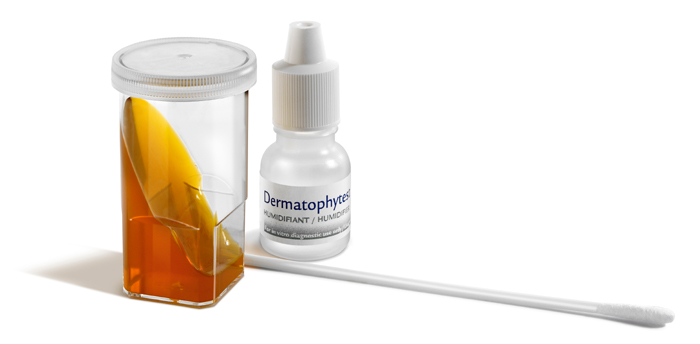Dermatophytest
Detection of dermatophytes via culture on selective medium
| Presentation | Advantages | |
|---|---|---|
|
Method: Rapid culture on DTM agar Analysis: Detection of pathogenic fungi from the genus Microsporum and Trichophyton, via culture on agar medium Sample: Skin scrape, skin swab, hair, feather Preparation: 2 minutes Reading: 2 to 14 days Storage: 16 months between 2°C and 8°C, 6 months at room temperature Presentations: 6 tests, 18 tests Reliability: The reference method for the culture of dermatophytes is culture on DTM (Dermatophyte Test Medium) (1) |
|
| Why to use Dermatophytest ? |
|---|
|
Dermatomycoses have a significant zoonotic potential.(2) The spores which are disseminated by infected animals, colonize keratinized zones (hair follicles, cornified layers, claws), where they form hyphae and generate an inflammatory reaction that may become chronic. Culture is the most reliable method for the detection of dermatophytes (3). Direct examination of hair and Wood's lamp test lack sensitivity. |
| When to use Dermatophytest ? |
|---|
|
Dermatophytest is recommended in cases of localized or multifocal alopecia, crusty or squamous dermatosis, to identify the presence of dermatophytes. For secondary infected lesions, Dermatophytest can be used to assess the need for antifungal treatment as well. Dermatophytest can be used to identify asymptomatic or transient mechanical carrier animals to prevent the zoonotic risk for sensitive people (4). |
Bibliographical references
(1) CARUSO K.J. et coll. Skin scraping from a cat [dermatophytosis]. Vet Clin. Pathol, 2002,31,13-15
(2) CARLOTTI D.N., PIN D. Aspects cliniques, histopathologiques, diagnostic différentiel et traitement des dermatomycoses canines et félines. Ann Med Vet, 2002, 146, 85-96
(3) MORIELLO K.A. Practical diagnostic testing for dermatophytosis in cats. Vet Med, 2003, 98, 859-875
(4) MIGNON B et coll. Le portage asymptomatique de Microsporum canis chez le chat. Annales de Médecine Vétérinaire, 2001, 145, 174-177


 Dermatomycoses are caused by the proliferation of Microsporum and Trichophyton in cats, dogs, rodents or lagomorphs.
Dermatomycoses are caused by the proliferation of Microsporum and Trichophyton in cats, dogs, rodents or lagomorphs.